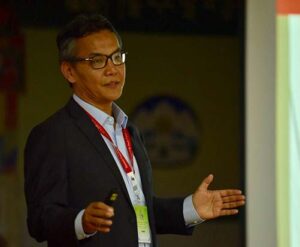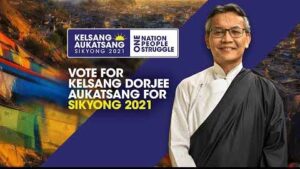 PROFILE:
PROFILE:
• Born in Kalimpong in 1968
Education:
• Attended the Central School for Tibetans (Herbertpur)
• Attended St. Augustine’s School in Kalimpong
• Attended St. Joseph’s Academy in Dehradun
• Earned his BA in English Literature at the University of Delhi
• Earned his MA in Law and Diplomacy at Tufts University
Work History:
• Leadership Team of Regional Tibetan Youth Congress of Delhi (1988-1991)
• President and Vice President of Capital Area Tibetan Association (1992-1996)
• Member of International Campaign for Tibet (1993-1996)
• Member (2005-2010) and President (2010-2011) of Tibetan Association of Northern California
• Representative of His Holiness the Dalai Lama in North America (2013-2016)
• Special Advisor to Sikyong, Chief Resilience Officer of the Central Tibetan Administration (CTA), and Director of the Social and Resource Development Fund (2011-2020)
Key Points:
• Transform the Tibetan freedom movement, government and educational system to fit today’s conditions
• Increase funding and coordination to preserve Tibetan culture and language
• Promote youth participation in CTA governance
• Expand global visibility and support for the Tibetan struggle and the MiddleWay Approach
• Strengthen the economic self-reliance of Tibetans through public private partnerships
Former representative in North America Kelsang Dorjee Aukatsang has entered the race for the Sikyong bid after announcing his candidacy on his campaign website last month. With his intimate, decade-long involvement in Central Tibetan Administration (CTA) affairs, Aukatsang believes he may even have a “head start” in serving the Sikyong position if he gets elected to the chair. This, he explains, is possible due to his “deep and close understanding of the current situation, the current needs, the opportunities, and what needs to continue,” enabling him to “hit the ground running” as the next leader of the Tibetan government.
One strategy of the current administration which Aukatsang plans to advance is the Five-Fifty Vision*. He places particular emphasis on the ‘Five’ in its name: “We really need to get things done in the five years – we don’t have a lot of time.” To implement this vision, he plans to carry out five definitive initiatives as the next Sikyong. The first three involve transformations of the current Tibetan freedom struggle, the CTA government and the education system in order to keep them up to date with recent conditions and developments of the world and the Tibetan issue. The transformations include shifting the focus of the freedom struggle from “the abyss of a frozen conflict” to devising incentives for the reestablishment of Sino-Tibetan dialogue, increasing digital capabilities of the CTA to become a transnational body, and raising the quality of the Tibetan education system in exile through digitalisation and the enhancement of the Basic Education Policy**. While honouring the present model of these institutions as “a legacy of the past which worked amazingly well for its time,” Aukatsang urges the need to “hold on to the things that continue to serve us, and reorient the rest to meet the new challenges and opportunities.”
 The latter two initiatives of Kelsang Aukatsang’s manifesto include the preservation of the Tibetan language and culture and the strengthening of Tibetan economic resilience. To address the recent increase in the number of students who cannot communicate in the Tibetan language, Aukatsang proposes the establishment of a Tibetan Language Fund which would provide support for professionals and teachers working to gain expertise in the language. Furthermore, indicating the current lack of coordination between organisations focused on cultural preservation, he plans to restore the Department of Religion and Culture for the formation of “a comprehensive plan to promote Tibetan culture.” In order to strengthen the economic resilience and self-reliance of Tibetans, he plans to shift the CTA’s strategies to a “public private partnership approach,” away from the current model of “welfare and entitlement.”
The latter two initiatives of Kelsang Aukatsang’s manifesto include the preservation of the Tibetan language and culture and the strengthening of Tibetan economic resilience. To address the recent increase in the number of students who cannot communicate in the Tibetan language, Aukatsang proposes the establishment of a Tibetan Language Fund which would provide support for professionals and teachers working to gain expertise in the language. Furthermore, indicating the current lack of coordination between organisations focused on cultural preservation, he plans to restore the Department of Religion and Culture for the formation of “a comprehensive plan to promote Tibetan culture.” In order to strengthen the economic resilience and self-reliance of Tibetans, he plans to shift the CTA’s strategies to a “public private partnership approach,” away from the current model of “welfare and entitlement.”
In line with his broader vision to modernise and rejuvenate the freedom struggle, Aukatsang highlights the importance of increasing youth participation in both the CTA and the greater Tibetan freedom movement. Under his leadership, Aukatsang promises that at least one of the Kalon [Cabinet] positions will be taken up by a representative of Tibetan youth, and a new “youth division” in the Department of Home will be established. “We need that fresh energy, the fresh blood which only the youth can bring,” he states in his campaign video.
Kelsang Aukatsang believes that the fundamental imperative of a successful Tibetan freedom struggle is unity – unity as “one nation, one people and one struggle.” He acknowledges the role of the “ruthless” Chinese government in hindering the continuous Tibetan struggle for freedom. Yet, Aukatsang also believes there are weaknesses in the Tibetan community itself that are undermining its potential. “Our Buddhist faith teaches us that in order to end suffering and affect external change we must first transform ourselves. […] We have it in us to confront our internal deficiencies and realise our dream,” he explains. When this unity is achieved, Aukatsang envisions that “no obstacles and no forces are big enough to prevent [Tibetans] from realising the dream of a free Tibet.”
*The Five-Fifty Vision was introduced in 2017 by Sikyong Lobsang Sangay and the CTA, aiming to settle the Tibetan issue by 2022 and to maintain the resilience of the Tibetan government, people, culture and freedom struggle for the next fifty years.
**The Basic Education Policy was initiated in 2004 by the CTA. The policy promotes the integration of academic knowledge and Tibetan values in the educational system.
For more about the election click here




 Print
Print Email
Email